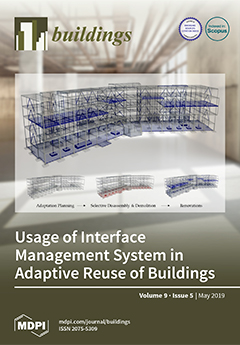Most of the school buildings in Italy are high energy-demanding buildings with no ad-hoc ventilation systems (i.e., naturally-ventilated buildings). Therefore, reducing the heat losses of schools represent the main aspect to be dealt with. Nonetheless, the indoor air quality of the building should
[...] Read more.
Most of the school buildings in Italy are high energy-demanding buildings with no ad-hoc ventilation systems (i.e., naturally-ventilated buildings). Therefore, reducing the heat losses of schools represent the main aspect to be dealt with. Nonetheless, the indoor air quality of the building should be simultaneously considered. Indeed, to date, energy consumptions and air quality are considered as incompatible aspects especially in naturally-ventilated buildings. The aim of the present paper is to evaluate the effect of different ventilation and airing strategies on both indoor air quality and energy consumptions in high energy-demanding naturally-ventilated classrooms. To this purpose, an Italian test-classroom, characterized in terms of air permeability and thermophysical parameters of the envelope, was investigated by means of experimental analyses and simulations through CO
2 mass balance equation during the heating season. The air quality was assessed in terms of indoor CO
2 concentrations whereas the energy consumptions were evaluated through the asset rating approach. Results clearly report that not adequate indoor CO
2 concentrations are measured in the classroom for free-running ventilation scenarios even in low densely populated conditions (2.2 m
2 person
−1), whereas scheduled airing procedures can reduce the indoor CO
2 levels at the cost of higher energy need for ventilation. In particular, when airing periods leading to the air exchange rate required by standards are adopted, the CO
2 concentration can decrease to values lower than 1000 ppm, but the ventilation losses increase up to 36% of the overall energy need for space heating of the classroom. On the contrary, when the same air exchange rate is applied through mechanical ventilation systems equipped with heat recovery units, the ventilation energy loss contribution decreases to 5% and the overall energy saving results higher than 30%. Such energy-saving was found even higher for occupancy scenarios characterized by more densely populated conditions of the classroom typically occurring in Italian classrooms.
Full article





